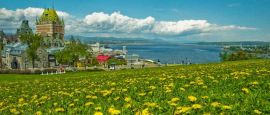Québec City's 'Lower Town' is a thicket of 17th-century streets centred on Place Royale. For art lovers, the Notre-Dame de Québec Basilica houses a unique collection.
Quebec things to see and do
Tourist offices
Address: Suite 100, 1225 rue Peel, Montréal, QUéBEC, H3B 4V4, Canada
Tel: +1 877 266 5687; +1 514 873 2015.
Opening Hours: Daily 0900-1700.
www.bonjourquebec.com
Place des Arts is the home of the Montréal Symphony Orchestra and several theatres offering year-round drama, music, ballet and opera. Both the Montréal Museum of Fine Arts and the Museum of Contemporary Arts of Montréal have good collections.
La Route Verte (the 'Green Circuit') boasts over 4,000km (2,485 miles) of marked paths and roadways. The St Lawrence River Valley is good for moderate cycling, while the hilly Laurentians region is more challenging. Mountain bike enthusiasts head for parks and nature reserves, especially Parc de la Jacques-Cartier and Mont-Sainte-Anne, both within easy reach of Québec City.
Québec City's Winter Carnival (www.carnaval.qc.ca/en), held in late January to mid February, is one of the largest Lenten festival in the world. It is a thrilling spectacle of parties, ice baths, dog sled races, ice palaces, sculptures and snowmobile races.
In the Gaspésie region, highlights include the Rocher Percé ('the pierced rock', a massive, arched sandstone rock rising from the Atlantic), and Gaspésie Provincial Park, which protects herds of caribou in a beautiful landscape of woods, lakes and streams.
Cosmopolitan metropolis Montréal has an unusual underworld - a series of underground shopping and recreation complexes, linked by walkways and the metro, and centred on Place Ville-Marie. Other architectural highlights include the Biodôme (the former Olympic velodrome, now an exotic indoor zoo), and the fascinating Canadian Centre for Architecture.
Vieux-Montréal, the historic waterfront section, has been carefully restored and contains many beautiful buildings and gathering places including Place Jacques-Cartier; the former French governor's residence, Château Ramezay; the city's oldest chapel, Notre-Dame-de-Bonsecours; and Pointe-à-Callière, the Montréal Museum of Archaeology and History.
Old city walls and green copper roofs are the defining characteristics of Québec City. The provincial capital is the only fortified city in North America and is one of the most 'European' cities on the continent, with a 95% Francophone population. A UNESCO World Heritage Site, it celebrated its 400th anniversary in 2008.
Québec boasts outstanding winter sports facilities, a long season, plentiful snow and around 80 ski centres. The main regions are the Laurentians, the Eastern Townships and the Greater Québec/Charlevoix area. Cross-country skiing is very popular, as are snowmobiling, snowshoe trekking, ice fishing and ice climbing.
Québec is home to countless food and drink festivals, such as the many events celebrating the maple syrup harvest from March until mid April. Érablières (maple farms) and cabanes à sucre (sugar shacks) are sprinkled through the province. You can watch the harvest and sample maple toffee (made by pouring molten syrup onto fresh snow).
Miles of white sandy beaches and a host of unspoilt fishing villages await intrepid travellers in the Magdalen Islands, 215km (134 miles) east of the Gaspé Peninsula in the Gulf of St Lawrence.
While in Québec City, you can wander through the cobblestoned streets and shaded squares of the 'Upper Town', which has fine 18th- and 19th-century architecture, notably the Place D'Armes and the iconic Fairmont Le Château Frontenac hotel (www.fairmont.com/frontenac). Energetic tourists climb 310 wooden steps to the Citadel, which affords incredible views across the river.
The Duplessis region (part of a bigger, largely rural area called the Côte-Nord) is the site of some of the earliest landfalls in the New World, made by the Vikings. The bizarre geological formations of nearby Mingan Archipelago are best explored by boat.
If you're an outdoorsy type, you can enjoy a variety of watersports, from white-water rafting (especially on the Rivière Rouge) to gentle boating. Canoes, kayaks and sailboards are available to hire in many provincial and national parks. The St Lawrence River has excellent facilities for sailing.
From May to October, whale-watching tour passengers can see up to 12 species including humpbacks in the St Lawrence. In early March, thousands of harp seals give birth on the ice floes of the Magdalen Islands. You can take a helicopter ride over the area. Be forewarned that this is also the season of the controversial seal hunt, so you may encounter both hunters and activists.
The Outaouais region of western Québec, near Ottawa, is home to aerial parks where you can walk or zip line through the forest canopy, white-water rafting spots, caves, bungee jumping sites, unspoiled Gatineau Park and Omega Park (www.parc-omega.com), as well as one of the largest log buildings in the world (now the Fairmont Le Château Montebello hotel).
Do you have any Feedback about this page?
© 2025 Columbus Travel Media Ltd. All rights reserved. No part of this site may be reproduced without our written permission, click here for information on Columbus Content Solutions.








 You know where
You know where